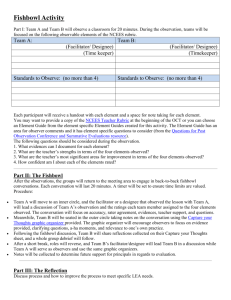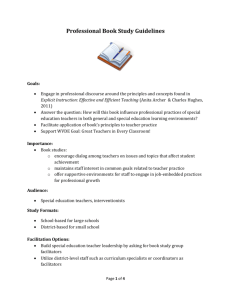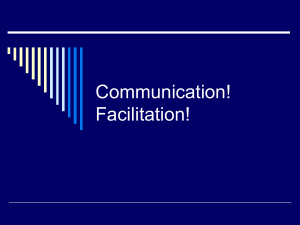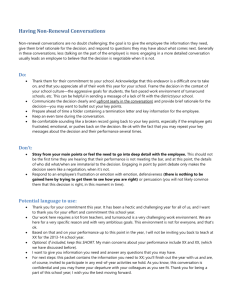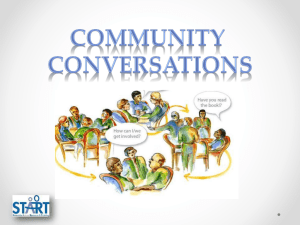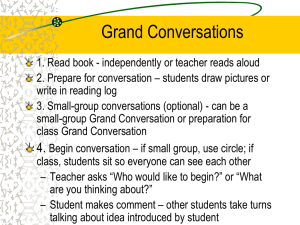Application Exercise 5.6 Fishbowl Enneagram
advertisement
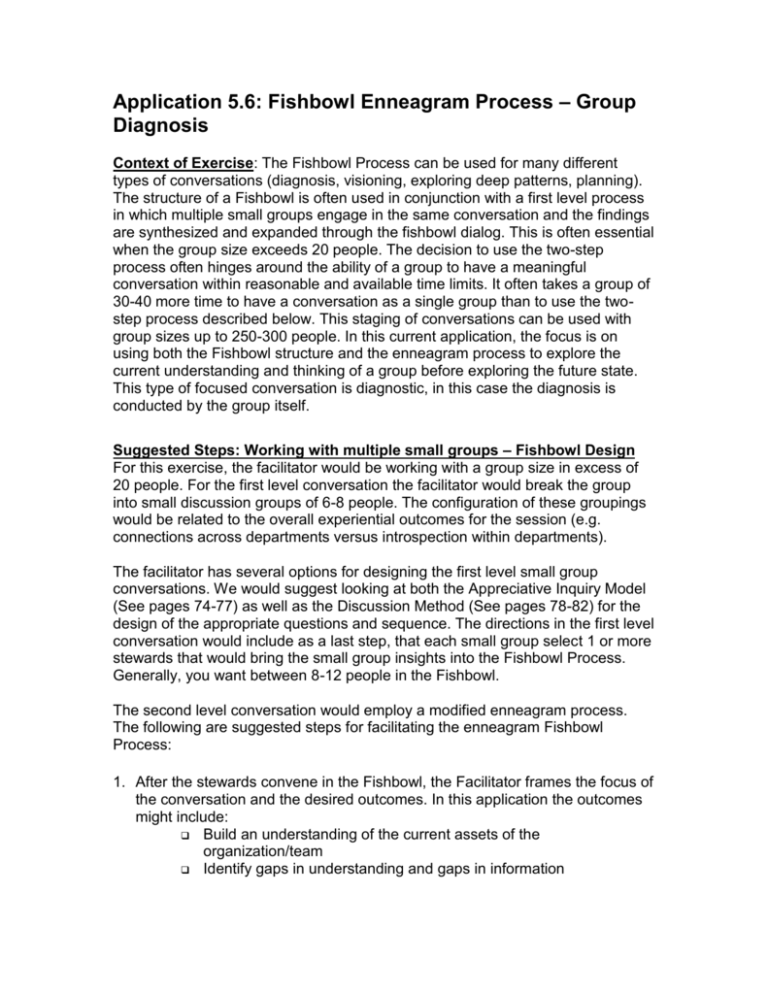
Application 5.6: Fishbowl Enneagram Process – Group Diagnosis Context of Exercise: The Fishbowl Process can be used for many different types of conversations (diagnosis, visioning, exploring deep patterns, planning). The structure of a Fishbowl is often used in conjunction with a first level process in which multiple small groups engage in the same conversation and the findings are synthesized and expanded through the fishbowl dialog. This is often essential when the group size exceeds 20 people. The decision to use the two-step process often hinges around the ability of a group to have a meaningful conversation within reasonable and available time limits. It often takes a group of 30-40 more time to have a conversation as a single group than to use the twostep process described below. This staging of conversations can be used with group sizes up to 250-300 people. In this current application, the focus is on using both the Fishbowl structure and the enneagram process to explore the current understanding and thinking of a group before exploring the future state. This type of focused conversation is diagnostic, in this case the diagnosis is conducted by the group itself. Suggested Steps: Working with multiple small groups – Fishbowl Design For this exercise, the facilitator would be working with a group size in excess of 20 people. For the first level conversation the facilitator would break the group into small discussion groups of 6-8 people. The configuration of these groupings would be related to the overall experiential outcomes for the session (e.g. connections across departments versus introspection within departments). The facilitator has several options for designing the first level small group conversations. We would suggest looking at both the Appreciative Inquiry Model (See pages 74-77) as well as the Discussion Method (See pages 78-82) for the design of the appropriate questions and sequence. The directions in the first level conversation would include as a last step, that each small group select 1 or more stewards that would bring the small group insights into the Fishbowl Process. Generally, you want between 8-12 people in the Fishbowl. The second level conversation would employ a modified enneagram process. The following are suggested steps for facilitating the enneagram Fishbowl Process: 1. After the stewards convene in the Fishbowl, the Facilitator frames the focus of the conversation and the desired outcomes. In this application the outcomes might include: Build an understanding of the current assets of the organization/team Identify gaps in understanding and gaps in information 2. Identity a sense of the shared outcomes and intentions for the future of the organization Identity the patterns that restrain the organization from being as successful as desired. Identify some next steps in moving from the current state conversation to the future state outcomes. The facilitator would then take the group through the following set of questions. Generally, the facilitator would design and pose one question for each point on the Enneagram, realizing that they may need to probe with other follow-up questions based on group response and dynamics. Current Identity Structures Strategies Intention Deep Learning Tensions Issues Relationships Connections Information Will The Work Principles Standards The specific sequence of questions: Current Identity: From your prior conversations in small groups, what stand out as the most critical assets of the organization and why? What are the positive and negative stories that seem to run the culture of the team or organization? What is the current energy level around change in the organization? On a scale of 1-10 what is the level of credibility in current management/leadership ability and desire to create change? Information: What is considered open information, and what information is unavailable to people in the system? What is the perceived level of importance around accessibility to information? Relationships and Connections: How would people describe the level of connections within and across the organization? People, programs and systems. Intention: Who seems to really own the current outcomes of the organization? Are these intentions and outcomes espoused, inferred or actually in practice? What new powerful intentions seemed to arise from the small group conversations? Principles and Standards: What set of rules and principles seem to be running the organization? Where are these coming from, and are the effective? Tensions and Issues: When delving deeper into the issues, what recurring patterns of behavior or ways of operating seem to be subverting their success? Strategies and Structures: Do the existing structures and strategies match with the desired outcomes and intentions of the organization? If not, why not? 3. The facilitator guides the group through the above conversation and charts the responses around the enneagram diagram at the center of a large wall. 4. At the conclusion of the conversation, the facilitator goes back through the various enneagram locations and checks with the group about the most significant insights in each area. 5. Deep Learning: As a simple way of closure for this conversation, what did we learn about our organization and about ourselves that we need to consider for the future? At this point the facilitator guides the group to identify next steps based on the outcomes from the prior conversation. The Work Given our diagnosis of the current state of our organization, what seem to be the most apparent and powerful next steps for this conversation and process?
